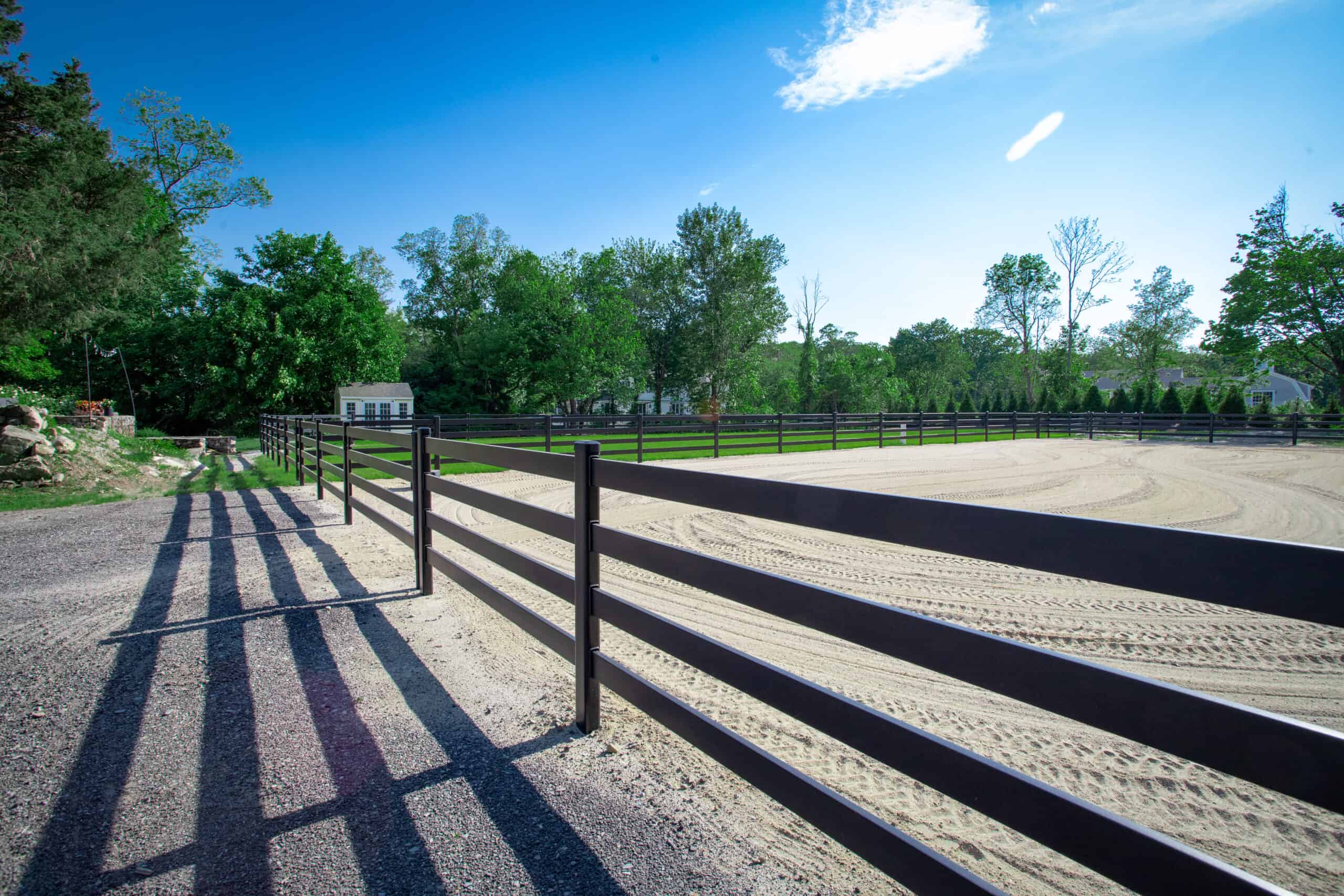Materials There’s a reason split rail fencing has defined American landscapes for over two centuries. Other fencing trends come and go, but that distinctive horizontal profile has stood the test of time (and for good reason).
What began as a practical solution using readily available materials has evolved into the gold standard for serious horse and livestock owners who understand that quality fencing is one investment you never regret making.
Nothing matches split rail for the perfect balance of form and function. Today’s split rail systems aren’t your grandfather’s wooden fences, either. Modern engineering and materials (particularly steel rail designs) have eliminated historical weaknesses while preserving the classic aesthetic that adds instant value to any property.
For horses especially, split rail provides the ideal psychological boundary: visible, substantial, and respected. Your animals can see it clearly, unlike wire options that lead to dangerous collisions. They can’t push through it like flimsy field fence. And most importantly, it won’t entangle or injure them when they inevitably test its limits.
Below, we’ll show you why discriminating ranchers consistently choose split rail over all other options.
What Is Split Rail Fencing?
Split rail fencing is a traditional horizontal barrier constructed of long wooden rails or steel tubes that rest between posts. This creates a stacked appearance without vertical pickets or mesh. This open design provides clear property boundaries and livestock containment while preserving views and maintaining a classic rustic aesthetic.
Split rail fencing gained popularity for its simplicity and efficiency back in the day of early American settlers. Traditional designs feature 2-4 horizontal rails set at strategic heights to contain specific livestock, typically standing 4-5 feet tall. The most common configuration (known as “horse height”) places rails at approximately 18″, 36″, and 52″ from ground level. This creates effective containment while allowing safe visibility for both horse and rider.
Unlike privacy fences or mesh systems, split rail establishes clear boundaries without creating visual barriers or wind resistance. This makes it great for larger properties where maintaining sightlines and natural landscapes is important. The space between rails also allows wildlife movement while still containing larger livestock.
Everyone wins (including you).
The Evolution from Wood to Steel
The greatest revolution in split rail fencing came with the transition from wood to steel construction. Traditional wooden split rail (typically cedar or locust) offers natural beauty but requires regular maintenance and replacement every 10-15 years. Today’s steel rail systems maintain the identical aesthetic profile while delivering 30+ year lifespans with minimal maintenance requirements.
Modern steel split rail incorporates engineering innovations like flexible mounting systems that absorb impact to prevent both rail damage and animal injury. Premium systems feature:
- Smooth-surfaced rails that eliminate splinter hazards
- Specialized coatings that resist rust and weathering
- Precision manufacturing that guarantees consistent quality across every section
Why Split Rail Fencing Is the Best for Horses
We’ve never met a serious horse person who didn’t eventually come around to split rail fencing. Sure, folks try other options when they’re starting out—we all make those mistakes. But after you’ve pulled a panicked horse from tangled wire at 2 AM or replaced a broken board for the fifth time in a month, you start to understand why generations of ranchers have sworn by split rail.
Pros
- You can actually see them: Horses are flight animals with eyes on the sides of their heads. When they get spooked (and they will), they need to see what they’re running toward. With split rail, that horizontal profile stands out clear as day, even when your mare is in full panic mode after spotting a plastic bag blowing across the pasture.
- Horses respect it: There’s something about those solid rails that makes horses think twice. They see it, understand it, and generally stay the hell away from it.
- Won’t slice your horse to ribbons: When’s the last time you bandaged up a nasty laceration from your horse hitting a split rail? Probably never. Those smooth surfaces—especially on steel rails—just don’t create the kinds of injuries we see with other options.
- Stands up to equine nonsense: Honestly, horses are glorified destruction machines. They’ll lean on it, scratch on it, and test it in ways you’d never imagine. Steel split rail takes this abuse in stride.
- Configurable for jumpers and Houdinis: Got a Thoroughbred who thinks he’s an Olympic jumper? Add a fourth rail. Belgian draft who’s surprisingly nimble? Adjust those heights. Split rail adapts to whatever equine personality you’re dealing with, without requiring a complete system replacement.
- Doesn’t become a sail in high winds: Anyone who’s rebuilt fencing after a storm knows the value of wind pass-through. Split rail lets those gusts blow right between the rails instead of catching them like a ship’s sail. This means your fence stays standing when others are scattered across the county.
Cons
- It isn’t cheap up front: Quality split rail systems, especially steel ones, hit the wallet hard initially. But we’ve replaced enough “budget” fencing to know the cheapest option always becomes the most expensive over time.
- Small critters walk right through: If you’re trying to keep in chickens or goats along with your horses, you’ll need some modifications. Those spaces between rails might as well be an open gate for anything smaller than a yearling.
- Don’t cut corners on installation: Folks try to save by stretching the post spacing or skimping on post depth. Two years later, they’re rebuilding. Do it right the first time—proper depths, proper spacing, proper bracing on corners and gates.
- Stallions might need extra convincing: Got a stud feeling his oats in spring? Standard configurations might not be enough. We’ve seen determined stallions require some creative adaptations, though the right steel rail system handles even these powerhouses with thoughtful design.
How to Choose the Right Material for Your Split Rail Fence
Not all split rail is created equal. We’ve seen folks drop good money on the wrong material for their situation and regret it for decades. Your choice here matters as much as deciding which truck to buy or which saddle fits your horse. It’s a long-term commitment that’ll either make you smile when you drive through your gate or curse every time a rail breaks.
| Material | Lifespan | Maintenance | Strength | Weather Resistance | Initial Cost | Appearance | Best For |
| Cedar | 10-15 years | Moderate | Good | Fair | $$ | Natural, weathers to silver-gray | Decorative boundaries, light duty |
| Pressure-Treated Pine | 15-20 years | Moderate | Good | Good | $$ | Greenish tint, rougher texture | Budget-conscious horse owners |
| Vinyl/PVC | 20-25 years | Low | Fair | Good (brittle in extreme cold) | $$$ | Clean white or tan, doesn’t weather | Front-facing property, show barns |
| Traditional Locust | 15-25 years | Moderate | Very Good | Good | $$$ | Rustic, natural durability | Historical properties, traditionalists |
| Steel | 30+ years | Minimal | Excellent | Excellent | $$$$ | Modern, clean lines, various colors | Serious horse operations, lifetime solution |
Materials Breakdown
- Steel: We won’t pretend we’re unbiased here. Steel is the superior choice for safety, durability, maintenance, and investment.
- Cedar: Looks beautiful for the first few years, has that nice aroma, and feels authentically western. Problem is, after about year seven, you’ll start replacing rails regularly. By year 12, you’re basically rebuilding the whole thing. Fine for marking your driveway entrance, but we wouldn’t trust it with animals you care about long-term.
- Pressure-Treated Pine: The working man’s compromise. It’ll last longer than cedar thanks to those chemicals, but you’ll still battle warping, splitting, and the occasional break when your draft horse decides to test it. Expect to replace about 10-15% of your rails every five years. Not terrible if you’re handy, frustrating if you’re not.
- Vinyl/PVC: Looks mighty pretty when it goes in, but that stuff gets brittle as grandma’s china during February cold snaps. Good for front paddocks visible from the road where appearances matter most.
- Traditional Locust: The old-timers’ favorite. Naturally rot-resistant hardwood that’ll outlast pine by a decade. Problem is, it’s getting harder to source quality locust these days, and the cost difference between this and steel has narrowed significantly. Still, there’s something beautiful about those chunky, imperfect locust rails if you’re going for that historical ranch aesthetic.
Choose Split Rail Fencing You Can Trust
Your property and the animals you care for deserve fencing that won’t let you down when it matters most. We’ve seen firsthand how the right split rail choice provides decades of worry-free security, while the wrong one becomes a constant source of headaches and repair bills.
Whether you’re fencing five acres or five hundred, we’re ready to help you choose the perfect steel split rail system for your specific needs. Reach out today for a no-obligation consultation—because the fence you choose now will either work for you or against you for years to come.



